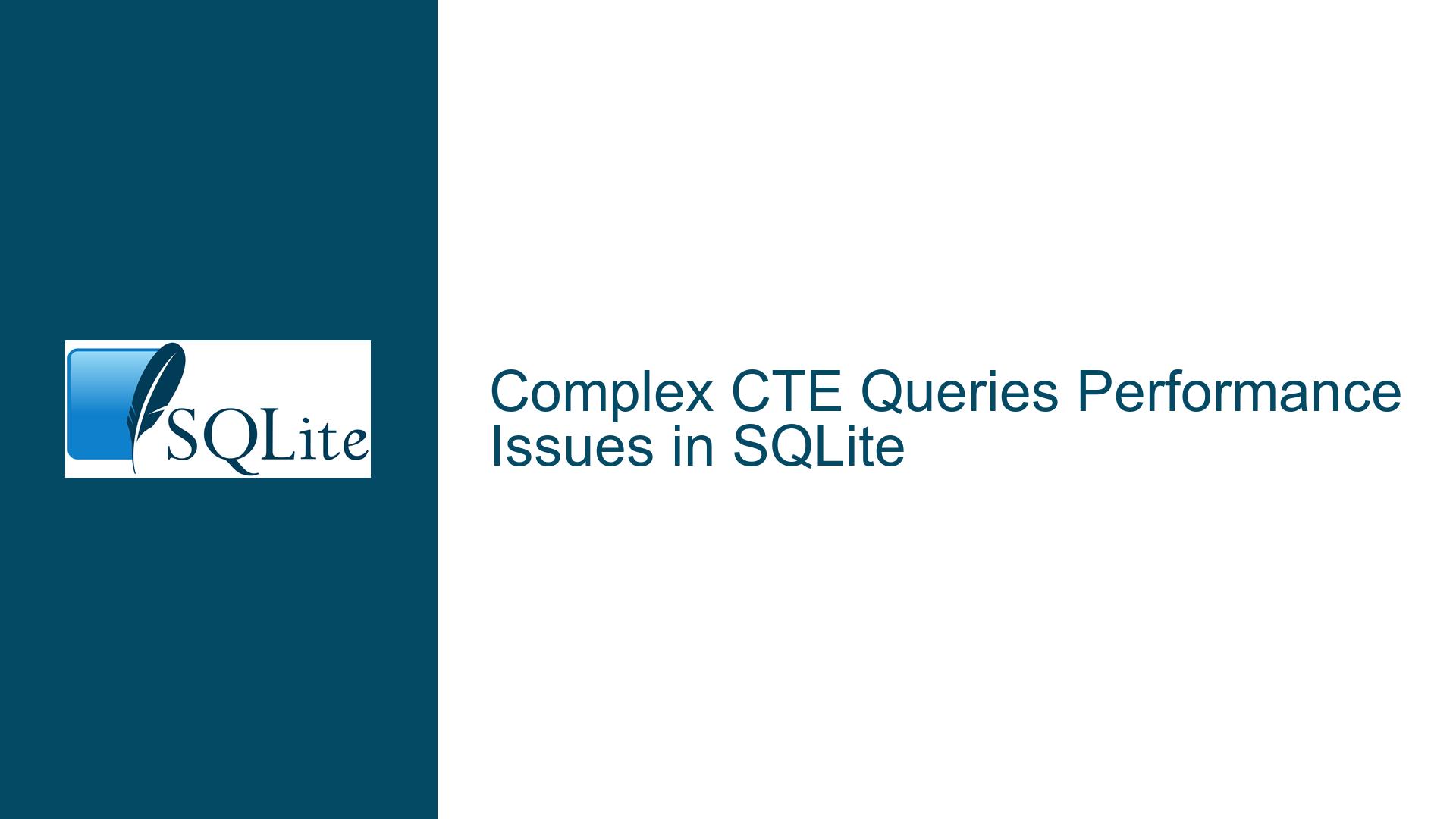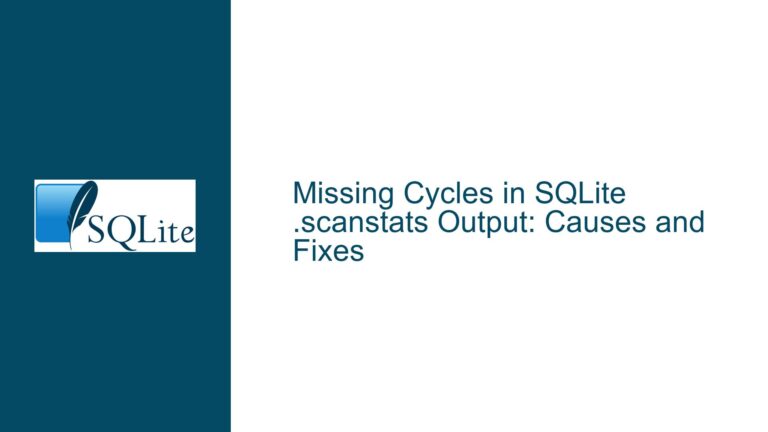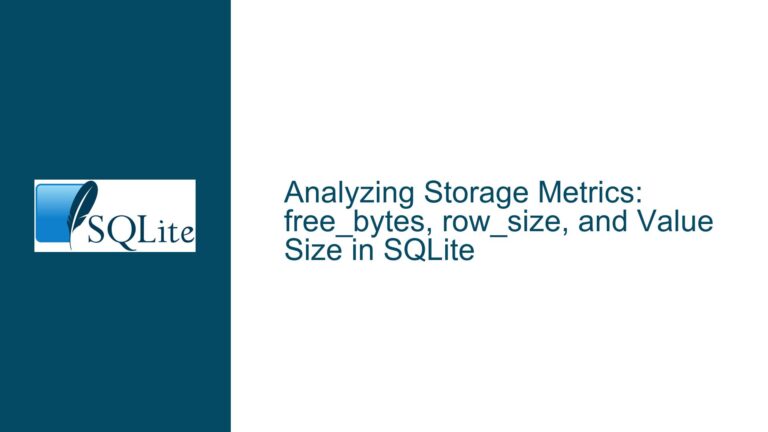Complex CTE Queries Performance Issues in SQLite
Performance Degradation in Complex CTE Queries Post Version Upgrade
The recent upgrade to SQLite version 3.41.0 has raised significant concerns among users regarding the performance of complex queries utilizing Common Table Expressions (CTEs). A user, Jean-Noël Mayor, reported a dramatic slowdown—up to 50 times slower—when executing queries that involve multiple CTEs after the upgrade. Initially, the user suspected that the issue might be related to Python, as no problems were observed on a personal laptop using an earlier SQLite version. However, similar performance issues were encountered on different systems, confirming that the problem was linked to the SQLite version itself.
The user conducted extensive tests by comparing different SQLite versions and identified that the performance degradation began between versions 3.40.1 and 3.41.0. The tests involved executing complex queries on a table created for events, which included random records generated through recursive CTEs. The execution times for various row counts revealed a stark contrast in performance across different versions. For instance, while version 3.40.1 executed a query on 30,000 rows in approximately 3.648 seconds, version 3.41.0 took an astonishing 236.377 seconds for the same operation.
The complexity of the queries involved multiple CTEs that referenced each other, which added layers of difficulty in optimizing execution plans. The user provided a simplified version of their query to illustrate the issues faced:
WITH BASE AS (
SELECT e.*,
CASE
WHEN activity LIKE '1%' THEN 'No. 1'
ELSE activity
END AS extracted_name
FROM EVENTS e
), finished_books AS (
SELECT * FROM BASE WHERE finished = 1
), entries_same_activity_after_finished AS (
SELECT b.*, f.id AS id_before
FROM BASE b
INNER JOIN finished_books f ON b.extracted_name = f.extracted_name AND b.id > f.id
), details_relevant_activities AS (
SELECT b.*
FROM BASE b
INNER JOIN (SELECT DISTINCT extracted_name, id FROM entries_same_activity_after_finished) e
ON b.extracted_name = e.extracted_name AND b.id = e.id
)
SELECT b.*,
b.extracted_name ||
CASE WHEN d.id IS NULL THEN ''
ELSE 'D' END AS extracted_name_dupl
FROM BASE b
LEFT JOIN details_relevant_activities d ON b.id = d.id;
In this query, the use of multiple CTEs significantly complicates how SQLite processes and optimizes the execution plan. The user also shared timing comparisons for various row counts across different SQLite versions, highlighting the severe impact of the upgrade on performance.
Moreover, the query plans generated by SQLite for versions 3.40.1 and 3.48.0 illustrated a shift in how materialization was handled within these versions, further complicating performance expectations for complex queries involving CTEs.
The system information provided indicated that the user was operating on Fedora release 40 with an Intel i5-4210U processor, which should typically handle such queries efficiently under normal circumstances.
As discussions progressed within the forum thread, Richard Hipp suggested adding the MATERIALIZED keyword to the CTE definitions to potentially enhance performance by forcing materialization of intermediate results used multiple times within a query. Jean-Noël Mayor reported significant improvements upon implementing this suggestion, indicating that materialization could mitigate some of the performance issues introduced with version 3.41.0.
This overview highlights a critical issue affecting users who rely heavily on complex CTEs in their SQL queries after upgrading to newer SQLite versions, prompting further investigation into optimization strategies and potential adjustments in query design to restore expected performance levels.
Identifying Performance Issues in Complex CTE Queries
The performance degradation observed in complex queries utilizing Common Table Expressions (CTEs) after upgrading to SQLite version 3.41.0 can be attributed to several factors. These factors primarily revolve around changes in the query planner’s optimization strategies, the handling of materialization, and the inherent complexity of CTEs themselves.
Query Planner Optimization Changes
SQLite employs a cost-based query planner that evaluates multiple strategies to determine the most efficient execution plan for a given SQL statement. The introduction of version 3.41.0 appears to have altered how the planner handles complex queries, particularly those involving multiple CTEs. In earlier versions, the planner was more aggressive in materializing intermediate results for CTEs that were referenced multiple times within a single query. This behavior allowed SQLite to create temporary tables for these results, which significantly reduced repeated computations and improved overall query performance.
However, with the newer version, the optimization heuristics may have shifted towards a more conservative approach, leading to scenarios where CTEs are not materialized when they should be. This change can result in redundant calculations and increased execution time for queries that rely heavily on CTEs, especially when these expressions are complex or involve self-joins.
Materialization and Its Impact
Materialization is a crucial aspect of optimizing CTEs. When a CTE is materialized, its result set is computed once and stored temporarily, allowing subsequent references to utilize this precomputed data rather than recalculating it each time. This can drastically enhance performance for complex queries that reference the same CTE multiple times.
In SQLite version 3.35.0 and later, users can explicitly request materialization by using the MATERIALIZED keyword in their CTE definitions. This feature allows developers to control how intermediate results are handled, potentially mitigating performance issues introduced by changes in the query planner.
The lack of automatic materialization in certain scenarios can lead to significant slowdowns, particularly when dealing with large datasets or intricate queries involving multiple joins or aggregations. For instance, if a CTE is used multiple times without being materialized, SQLite may perform redundant calculations for each reference, leading to increased CPU usage and longer execution times.
Complexity of CTEs
CTEs are designed to simplify complex SQL queries by breaking them into manageable parts. While this modular approach improves readability and maintainability, it can also introduce performance challenges if not carefully managed. The complexity of nested CTEs or those that reference computed columns can lead to inefficient execution plans if the query planner struggles to optimize them effectively.
For example, consider a scenario where multiple CTEs are interdependent and involve self-joins on computed columns. If these computations are not optimized through proper indexing or materialization, the resulting execution plan may require extensive processing time due to repeated evaluations of the same expressions.
Moreover, recursive CTEs can exacerbate performance issues if they generate large interim result sets that must be processed before yielding final results. The recursive nature of these queries inherently increases their complexity and can lead to longer execution times if not optimized correctly.
Summary of Possible Causes
The following table summarizes the potential causes of performance degradation in complex CTE queries after upgrading SQLite:
| Cause | Description |
|---|---|
| Query Planner Optimization Changes | Altered heuristics in version 3.41.0 may lead to less aggressive materialization of CTEs. |
| Materialization Issues | Lack of automatic materialization can cause redundant calculations for repeatedly referenced CTEs. |
| Complexity of CTEs | Nested or interdependent CTEs may result in inefficient execution plans if not properly managed. |
Understanding these factors is essential for diagnosing performance issues in complex SQL queries using SQLite. By addressing these causes through careful query design and leveraging features like explicit materialization, developers can significantly improve query execution times and overall database performance.
Troubleshooting Steps, Solutions & Fixes for CTE Performance Issues
Addressing the performance issues associated with complex Common Table Expressions (CTEs) in SQLite requires a systematic approach to identify bottlenecks and implement effective solutions. This section outlines practical steps and strategies to enhance the performance of CTE-heavy queries, particularly in light of the challenges introduced by recent SQLite version updates.
Analyzing Query Execution Plans
The first step in troubleshooting slow CTE queries is to analyze the execution plans generated by SQLite. Using the EXPLAIN QUERY PLAN command allows developers to gain insights into how SQLite interprets the query and which operations contribute to longer execution times. By examining the execution plan, one can identify whether specific CTEs are being evaluated multiple times or if there are inefficient joins or scans that can be optimized.
For example, when a CTE is referenced multiple times within a query, it may lead to repeated evaluations unless explicitly materialized. In such cases, adding the MATERIALIZED keyword to the CTE definition can instruct SQLite to compute and store the results once, significantly improving performance.
Implementing Materialization
Materialization plays a critical role in optimizing CTE performance. By using the MATERIALIZED keyword, developers can ensure that a CTE’s result set is computed once and reused across multiple references. This approach reduces redundant calculations and speeds up query execution, particularly for complex queries where certain CTEs are used repeatedly.
Here’s an example of how to implement materialization:
WITH BASE AS MATERIALIZED (
SELECT e.*,
CASE
WHEN activity LIKE '1%' THEN 'No. 1'
ELSE activity
END AS extracted_name
FROM EVENTS e
)
SELECT * FROM BASE WHERE finished = 1;
In this case, the BASE CTE is materialized, allowing subsequent operations on it to leverage precomputed results.
Breaking Down Complex Queries
For intricate queries involving multiple interdependent CTEs, consider breaking them down into smaller components. Instead of nesting several CTEs within one query, execute each CTE separately and store intermediate results in temporary tables. This restructuring can lead to more manageable execution plans and improved performance.
For instance, instead of using a single complex query with nested CTEs:
WITH RECURSIVE complex_query AS (
-- Complex logic here
)
SELECT * FROM complex_query;
You could break it down into:
CREATE TEMP TABLE temp_results AS
SELECT * FROM intermediate_query;
SELECT * FROM temp_results WHERE condition;
This method allows for better indexing options on temporary tables and reduces the workload on the SQLite query planner.
Indexing Strategies
Effective indexing is essential for optimizing query performance. Ensure that columns frequently used in WHERE clauses or JOIN conditions are indexed appropriately. For example, if a CTE involves filtering on a specific column, creating an index on that column can significantly reduce lookup times.
Consider implementing partial indexes if only a subset of data is regularly accessed. This strategy conserves storage space while optimizing performance for specific queries.
Profiling and Monitoring
Utilize SQLite’s profiling tools to monitor query performance actively. The ANALYZE command can help identify which indexes are utilized during query execution and whether additional indexes might be beneficial. Regularly profiling your queries allows for ongoing optimization and adjustment based on changing data patterns.
Leveraging Temporary Tables
In scenarios where materialization does not yield sufficient performance gains or when dealing with particularly slow CTEs, consider using temporary tables as an alternative. Temporary tables can store intermediate results and allow for indexing, which can lead to faster subsequent queries.
For example:
CREATE TEMP TABLE temp_table AS
SELECT * FROM slow_cte;
SELECT * FROM temp_table WHERE condition;
This approach minimizes repeated evaluations of slow queries and takes advantage of indexed access patterns.
Conclusion
By systematically analyzing execution plans, implementing materialization where appropriate, breaking down complex queries, optimizing indexing strategies, and leveraging temporary tables, developers can effectively address performance issues associated with complex CTE queries in SQLite. These strategies not only enhance query execution times but also contribute to overall database efficiency and responsiveness. As SQLite continues to evolve, staying informed about best practices and leveraging new features will be essential for maintaining optimal performance in database applications.






